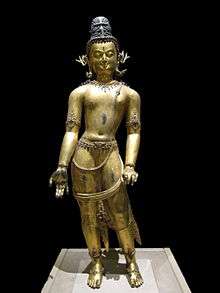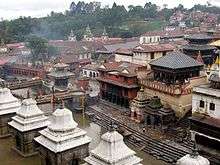Religion in Nepal

Nepal is a secular state. Prior to the movement for democracy in early 2006 and the sacking of King Gyanendra in 2008, the country was officially a Hindu state. Hinduism is the majority religion in the state and profoundly influences its social structure, while Buddhism (Tibetan Buddhism) is practiced by some ethnic groups (for example Newar) in forms which are strongly influenced by Hinduism; Kiratism otherwise is the grassroots native religion of populations belonging to the Kirati ethnicity. Islam and Christianity have made inroads and are the religious identity of small populations.
History
According to the 2011 census, 81.3% of the Nepalese population was Hindu, 9.0% was Buddhist, 4.4% was Muslim, 3.0% was Kiratist (indigenous ethnic religion), 1.42% was Christian, and 0.9% follow other religions or no religion.[1]
According to the 2001 census, 80.62 percent of Nepalese were Hindu, 10.74 percent Buddhist, 4.20 percent Muslim,[2] 3.60 percent Kirant (an indigenous religion), 0.45 percent Christian, and 0.4 percent were classified as other groups such as Bön religion. In 1971 Hindus were 89.4 percent of the population, Buddhists 7.5 percent, and Kirants statistically 0 percent. However, statistics on religious groups are complicated by the ubiquity of dual faith practices, particularly among Hindus and Buddhists. Moreover, shifts in the population's religious composition also reflect political changes.
The geographical distribution of religious groups in the early 1990s revealed a preponderance of Hindus, accounting for at least 87 percent of the population in every region. The largest concentrations of Buddhists were found in the eastern hills, the Kathmandu Valley, and the central Tarai; in each area about 10 percent of the people were Buddhist. Buddhism was more common among the Newar and Tibeto-Nepalese groups. Among the Tibeto-Nepalese, those most influenced by Hinduism were the Magar, Sunwar, and Rai peoples. Hindu influence was less prominent among the Gurung, Limbu, Bhote, Tamang and Thakali groups, who continued to employ Buddhist monks for their religious ceremonies. Since both Hinduism as well as Buddhism are Dharmic religions, they usually accept each other's practices and many people practice a combination of both.
In 2015, a new constitution was adopted and granted equal rights to all religions in Nepal.
Hinduism in Nepalese culture
It is even believed, according to Nepalese theology that Lord Brahma, Vishnu and Shiva had come to Nepal in the form of deer.[3]
Establishment of Nepal by Ne Muni
He used to perform religious ceremonies at Teku, the confluence of the Bagmati and Bishnumati rivers.[4] He is said by legend to have selected a pious cowherd to be the first of the many kings of the Gopala Dynasty.[5] These rulers are said to have ruled Nepal for over 100 years.[6] He selected Bhuktaman to be the first king in the line of the Gopal (Cowherd) Dynasty.[4] The Gopal dynasty ruled for 300 years. Yakshya Gupta was the last king of this dynasty. The Kirat Dynasty ruled for 550–700–800 years. The first king of Kirat Yalambar and Gasti was last king of this dynasty. The Licchavi dynasty ruled for 200–350 years. The Malla Dynasty ruled for 400–600 years. The Shah dynasty ruled for 300 years. However, this mythology can be challenged as no such name as Ne exists in Nepali or other Sanskrit-derived languages.
Flag of Nepal
It is believed that Lord Vishnu had organized the Nepali people and given them this flag, with the sun and moon as emblems on it.[7]
In a Hindu Purana, it is written that it was Lord Shiva who handed the flag to Lord Vishnu, and then Lord Vishnu to Lord Indra, for the purpose for battling demons.[8]
Gorakhnath and Gurkhas
It is said that Gorakhnath came to Nepal in the reign of the 8th Thakuri King.[9]
The Gurkhas of Nepal are the descendants of Gorakhnath of the Nath sect. Gorakhnath was a disciple of Machendranath, a backward-caste saint.
Machendrajatra is a national festival in Nepal to celebrate the birth of the saint. It is said that the Gurkha war-cry to this day is "Guru Gorakhnath ki jai".[10] It is more often said that their war cry is Jaya Mahakali, Ayo Gorkhali (Nepali: जय महाकाली, आयो गोर्खाली) (Glory to Great Kali, The Gorkhas are coming!)
According to a Terai myth, when the Pandavas were ascending to heaven, they all fell, but Bhima from the Pandava brothers was rescued by Gorakhnath.[11]
One Nepalese myth says that as Gorakhnath arrived in Nepal, the terrible dought in occurring in the period halted![11]
See also
- Buddhism in Nepal
- Hinduism in Nepal
- Islam in Nepal
- Judaism in Nepal
- Christianity in Nepal
- Bahá'í Faith in Nepal
References
- 1 2 Statistical Yearbook of Nepal - 2013. Kathmandu: Central Bureau of Statistics. 2013. p. 23. Retrieved 13 December 2015.
- ↑ Becoming an assertive minority
- ↑ History of Nepal: With an Introductory Sketch of the Country and People of Nepal By Daniel Wright
- 1 2 The Ancient Period
- ↑ W.B., P. 34 Land of the Gurkhas
- ↑ Balfour, P. 195 Cyclopædia of India and of Eastern and Southern Asia, :
- ↑ Gorkhapatra Corporation The Nepalese Perspective
- ↑ P. 10 The Lotus & the Flame: An Account on Nepalese Culture By Dhooswan Saymi, Dhūsvāṃ Sāyami
- ↑ P. 35 Nepal and the East India Companyby Bhairava Dat Sanwal
- ↑ P. 98 A Handbook of the Fighting Races of India by P. D. Bonarjee
- 1 2 P. 329 Encyclopedia of Religion and Ethics by James Hastings

